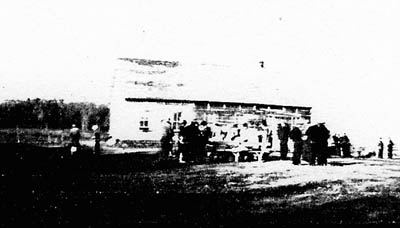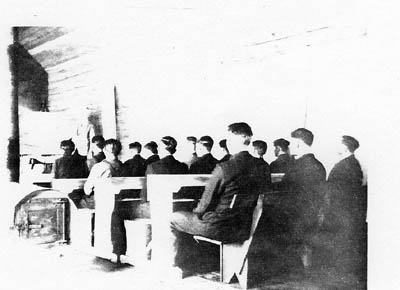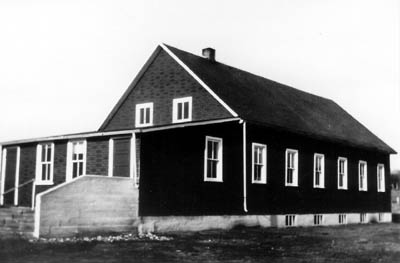 Index IndexPage |
 Previous Previoussection |
Section 5 |  Next Nextsection |


After the travelers arrived in Quebec and traveled by train to Saskatchewan, Peter got a summer job in Balgonie, Saskatchewan as a farmhand. Balgonie (see map page 30) is close to Regina. In the fall of 1925 he went to Rostern Academy where he apparently enjoyed school and did quite well learning English, returning to work in Balgonie the following summer. He also worked in a lumber camp before joining the Pauls' in Glenbush in 1927.Times were hard in beginning all over again. The Pauls' were among five families who moved to Glenbush from Waldheim in 1927. In 1928, 20 more adults joined their company.
At this time Nick and Sara and their children were living in a tall granary across the road from where their son, Peter Pauls later moved. Though the Pauls family suffered great personal loss in their first six months in Canada with the deaths of two of their children (Heinrich and Nicolai), they were joined by another daughter, Tina.
One of the more humorous episodes of Peter's early life happened in 1927. Now 18 years old, he had heard that there were lots of jack rabbits in Glenbush and sunk his summer savings into some equipment that he thought would make him rich quick. This equipment consisted of a gun and an apparatus with a light similar to that of a coal miner's light. With this light strapped to his head, all he had to do was pull the trigger to shoot the rabbit and the light would go on.
With money still very tight, Sara asked Peter how he was going to dry the skins. "Oh" he replied, "No problem! The top of the granary is tall and I'll just dry them there". He made his home with the Pauls family up until a year before he got married in 1934.
The Wiens children never regretted their decision to leave Russia but undoubtedly experienced homesickness for their family members left behind. Postage for overseas mail was two cents and even that was hard to come up with at time. Nonetheless, they were faithful in keeping correspondence with their parents in Russia.
Peter often found it hard to understand why the circumstances in Russia were so difficult and found it to be lonely living among strangers in Canada. His parents could no longer get out as the borders were closed. He longed for the presence of his parents - to have the chance to see them again and to talk to them. Ten years after his departure from Russia, he found it difficult at times. In a letter to Maria, he confessed that if he didn't have his Savior, he would have despaired long ago. In his Savior he found the comfort, wisdom and strength to go on.
As a young man, Peter was a terrible tease. Once he got started he never knew when to quit. He always had a prank or two up his sleeves to pull on some unwitting person.
On one particular Sunday, he was at some neighbor's home. He went the granary where some of the host's boys slept and relaxed for a while. With his eyes half closed, he saw the boys come in and thinking he was asleep, crept up to him to tie him up. When they made their move to act, he had the last laugh when he reached up and grabbed the individual instead.
 |
 |
| Area Map of Glenbush | Area Map of Balgonie |
In the beginning the Mennonite Brethren and the Mennonite General Conference churches had joint services in the Avery School. Because the school was not in a central location for the M.B. families, they moved into the vacant United church building in town, using it free of charge. At first they met every other week and then every week, choosing Nicolai Pauls as their first pastor, with their first service being held in 1928.
The church brought a parcel of land from the railroad on which to build their church. After an 8' x 10' basement was dug, they constructed a 22' x 32' church. This was completed in 1930 for a total cost of $236.00. The first service was held in this building in March of 1931. To keep warm, they had a large airtight heater right in the middle. All the lumber for this building was cut on Peter Wiens' sawing outfit.
It is not known when Peter became a Christian but it is believed that he accepted Jesus as his Savior after he arrived in Canada. On September 23, 1928, the church had their first baptism at Long Lake. Participants baptized and received into the church membership were 20 year old Peter, his sister, Margareta (Greda) and her husband, John Enns, and the Peter Bartels.
The immigrants also brought their musical talents along with them. Peter was in the first male quartet along with Nick Pauls, Henry Zimmerman and Jake Klassen. The church also had a choir led by Nicolai Pauls.
Peter brought a farm located five miles east of John and Margaret Enns' in section S.W.-24-49-14-W3rd. He lived here by himself for about a year before he married Maria Georgina Derksen from Borden, Saskatchewan on October 7, 1934. Together they formed a new home and family. His first independent address was:
Box 2
Glenbush, Sask.
Peter first set eyes on Maria when he attended a music course in Laird, Saskatchewan. The prime purpose of this event was to learn how to conduct and lead a choir. After each choir sang, the conductors were given an evaluation based on their performance. One of the choirs that gave a performance was the Borden M.B. church whose pianist was a talented but single lady named Maria Derksen.
 |
The First Glenbush M. B. Church building |
| Inside the original Church - note the heater in the aisle used to keep them warm! |
 |
 |
The New Glenbush M.B. Church Built in 1948 |
When it was his turn to conduct, he picked up his baton. In front of all those people, he became very nervous causing him to drop his stick. He handled the situation well by simply picking up a heavier one, made a joke about it and started all over. From the piano, Maria merely nodded at him and encouraged him to go on.

He first officially made contact with Maria by correspondence desiring to meet the young lady who had so encouraged him but the timing was wrong. They crossed paths again in the spring of '34 when he met her for the very first time. During their courtship, mostly handled by correspondence, they had a total of 3 dates before they married in October of '34.
Peter was known to be forgetful at time as well. On one occasion he had not received a letter from Maria for quite a time, only to remember six days later that he had stored a letter he had received from her in a pair of rubber boots which were at someone else's house.

They had no honeymoon in those days. Peter and Maria left for Glenbush the day after their wedding. In 1934, the speed limit was 15 mph and roads were rough with some of it not even graveled. Thus, it took them an entire day to drive the 90 miles to Glenbush stopping three times to patch a flat tire arriving in Glenbush after dark.
The home he brought his bride to was an unfinished log house set on a stone foundation. Although it wasn't yet finished, it was warm and it was home. The kitchen and pantry were heated by a wood range and a space heater kept the living room and bedroom warm. To make it look nice, they had to plaster and then white wash the walls. Their first ten years of farming were hard ones caused by drought, frost etc - but they were young, in love and enjoyed life.
Their first winter, Maria was alone much of the time. Every morning Peter was up at 3 a.m., hooked up four strong horses and went to the forest twelve miles away to haul wood. He'd be home by 3 p.m., unload his load, do his chores, have supper and go to bed.
Then in the spring, the neighbor would come over with his wood cutting equipment. With the help of other neighbors, they would cut the wood into cords which was later taken to the Glenbush train station and sold. In 1935 the price of a cord of wood cost about $2.00 which went towards buying a gang plow

One of the challenges they had to deal with was bedbugs (such as the one on the left) that came out of the boards. Peter got some powder that Maria sprinkled along the boards and the bedbugs were gone. Another time Maria found a mouse nest in her feather blanket.
In the early years, the pioneers didn't have any electricity or freezers, so most of the vegetables and meat had to be canned. They did, however, have an ice cellar, which was nothing more than a 6 cubic foot hole. Each spring, it was filled with snow, covered by a foot of fine straw or saw dust. Over this was erected a sod roof which kept the cellar cool. In this fashion things could be kept cold in the summer. In the winter they dipped the meat in ice water which preserved it until it was prepared and eaten.
For a number of years, Peter also operated a beef ring. They would do the butchering, cutting and wrapping. The farmer whose turn it was to deliver the animal would come the following morning, load the meat on his buggy and deliver the meat to the various homes in the ring. In this fashion they were always provided with fresh meat each week.
One of the things he inherited from his parents was his ability to be willing to share of himself with those around him. During one of the drought years, he and Maria provided shelter during the winter months to the Henry Krahns until they moved to their own place. He was served in community activities which included a term as a trustee for the Artichoke School district.
Peter was also a man of surprises. In 1940, he sold 5 pigs in order to buy a tall upright piano for Maria for Christmas. It seemed that everyone but Maria knew about this piano because it was to be his Christmas present for Maria that year. It wasn't hard to keep it secret from her since it didn't even arrive until the day before Christmas. Maria's piano abilities created many a memory for those in their home for years to come.
Peter was also a good mechanic. He had taken a course in mechanics in Winnipeg which enabled him to fix his machinery as well as others. Being the first to buy a tractor with steel rims, he was able to use it to his advantage.With this tractor, a trade was bartered that benefited everyone involved.

They had a breaking plow but there were many trees that needed to be cleared off the land. To help each other out, the neighbors would come and chop down the trees while Peter broke their land.
Peter and Maria had one of the biggest tractors in the area. When people started to drive cars, the community started a snow plough club and invested in a snow plough which was attached to Peter's tractor. It then became his responsibility to keep the roads open during the winter after a storm.

By 1949 crops were greatly improved, perhaps because of the availability of tractors and better machinery. It was in this year that they got their first pull type combine which was traded in two years later for a new self-propelled one. This was a big and expensive machine. In order to pay for the combine, Peter would do custom combining for the neighbors and surrounding districts. This combine remained in use until 1966 when it was sold at the farm auction.
 Index IndexPage |
 Previous Previoussection |
Section 5 |  Next Nextsection |